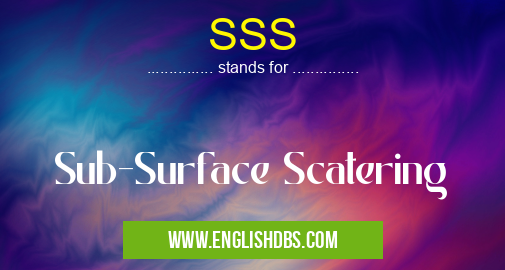What does SSS mean in PHYSICS
Sub-Surface Scattering (SSS) is a type of optical phenomenon where light particles are scattered by the objects they come into contact with. This effect appears in many aspects of everyday life, including the appearance of human skin, animal fur, and clouds in the sky. While traditional surface scattering techniques can approximate this effect, sub-surface scattering provides an additional layer of realism that takes rendering to a more believable level

SSS meaning in Physics in Academic & Science
SSS mostly used in an acronym Physics in Category Academic & Science that means Sub-Surface Scatering
Shorthand: SSS,
Full Form: Sub-Surface Scatering
For more information of "Sub-Surface Scatering", see the section below.
Essential Questions and Answers on Sub-Surface Scatering in "SCIENCE»PHYSICS"
What is Sub-Surface Scattering?
Sub-surface scattering is a technique used to simulate the way light interacts and scatters through translucent materials such as skin, wax, and marble. It simulates how light enters a surface and then reflects off of microscopic features within the material before exiting at a different point of the surface. This technique can be used in computer graphics to create more realistic visuals with greater complexity.
How Does Sub-Surface Scattering Work?
Sub-surface scattering works by combining two effects: refraction and diffusion. Refraction is when light passes from one material to another at an altered angle due to the change in refractive indices between the two materials. Diffusion occurs when light collides with smaller particles inside of the material, creating multiple reflections that scatter in random directions before exiting the surface at a different point than where it entered.
What are some of the applications of Sub-Surface Scattering?
Sub-surface scattering can be used for a variety of visual applications including skin rendering, vegetation rendering, wax or marble rendering, cloths simulation, fire and smoke simulation, water simulation, and more. It can also improve images in medical imaging systems for diagnosis purposes, and it can be used for prototyping 3D models or virtual spaces.
What Technologies are Used in Sub-Surface Scattering?
Technologies used in sub-surface scattering include ray tracing, Monte Carlo simulation techniques, photon mapping algorithms, texture mapping algorithms, global illumination algorithms, and procedural shaders such as subsurface screen space reflection (SSSR) and path traced ambient occlusion (PTAO).
How Long Does Rendering Take When Using Sub-Surface Scattering?
Rendering times vary depending upon the complexity of the scene being rendered. Generally speaking though sub-surface scattering renders typically take longer than traditional methods since they require more complex calculations to simulate accurate lighting conditions in scenes with highly detailed surfaces such as human skin or foliage.
Are There Any Limitations When Using Sub-Surface Scatterig?
Yes there are some limitations when using sub-surface scattering techniques such as memory usage issues which can cause slow render times due to increased complexity involved in dealing with massive datasets associated with large scale simulations; lower resolution meshes may lead to inaccurate results; noise artifacts might appear under certain conditions; and some scenes might contain physical objects that do not support sub-surface scattering techniques such as metal objects or highly reflective surfaces..
How Can I Optimize My Rendering Time When Using Sub-Surface Scattering?
Optimizing your rendering time when using sub-surface scattering requires careful planning ahead of time to ensure efficient results. Consider preprocessing methods which use less memory; distribute workloads across multiple machines if possible; use smaller meshes where possible; utilize GPU acceleration instead of CPU processing whenever possible; reduce noise via post processing techniques such as denoising; adjust sampling parameters according to requirement demands.
What Types of Materials Benefit Most From Sub Surface Scaterring?
Materials which exhibit strong subsurfaces properties such as skin tissue or food items benefit greatly from using this technique as it allows for greater realism while still preserving accuracy through incredibly fine details that would otherwise be lost without this technique. Natural elements like wood or stone surfaces exhibit strong subsurface optical effects which give them a beautiful look that can easily be created through SSS.
SSS also stands for: |
|
| All stands for SSS |
